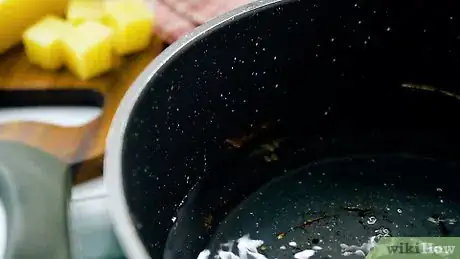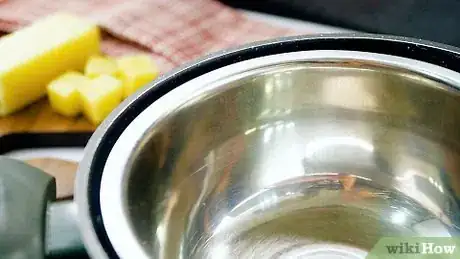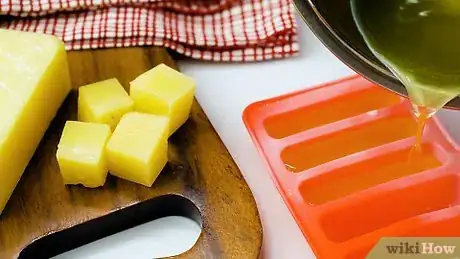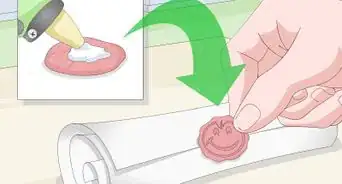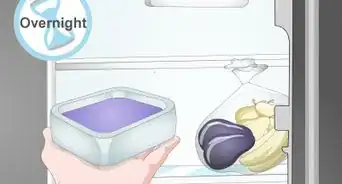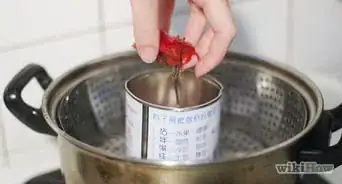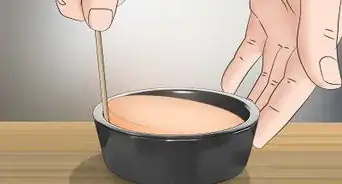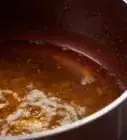This article was co-authored by David Williams. David Williams is a Professional Beekeeper and Bee Removal Specialist with over 28 years of beekeeping experience. He is the Owner of Bzz Bee Removal, a bee removal company based in the San Francisco Bay Area. Bzz Bee Removal locates, captures, and transports bees to local beekeepers to prevent colony collapse disorder.
There are 9 references cited in this article, which can be found at the bottom of the page.
wikiHow marks an article as reader-approved once it receives enough positive feedback. In this case, 100% of readers who voted found the article helpful, earning it our reader-approved status.
This article has been viewed 272,204 times.
Beeswax is a wonderful material to work with, but it can be dangerous when it’s hot. Melt it down slowly using low heat for the best results. With a few simple materials, you can easily prepare a double boiler, a crock pot water bath, or a solar oven to slowly to evenly warm up your beeswax. Make sure you’re constantly monitoring the melting beeswax so that it doesn’t scorch. Remember to never allow it to reach its flash point of 400 °F (204 °C), which is when its will ignite. If you melt your beeswax with a “low and slow” mindset, you’ll end up with a lovely golden liquid that you can pour out into molds or turn into any sort of project you desire.
Steps
Melting Beeswax in a Pot
-
1Find a large stock pot and a smaller metal bowl that will fit inside. If you already have a double boiler, you’ll use the 2 pots it comes with. If not, pick out a large stock pot for the base. Then, find a metal saucepan or bowl that fits comfortably inside your stock pot. Find one that can rest on the lip of the stock pot so that it doesn’t touch the bottom. Try a wide metal bowl or a smaller saucepan with a long handle. If you use a saucepan, rest the handle on the lip of the stock pot while the pan portion floats in the water.[1]
- Only use a metal bowl for the smaller piece; don’t use plastic or glass, which might melt or shatter.
- You won’t be putting any wax inside the stock pot, so it’s okay to use a pot you prepare food in. However, you will be placing the beeswax directly into the smaller saucepan or bowl, so choose an old one that you won’t be using for food preparation.
- If you’re using a tall metal pitcher or another bowl that does touch the bottom of the stock pot, place a metal cookie cutter at the bottom and set the smaller bowl on top of this. The cookie cutter will elevate the bowl off of the heat source.
-
2Line the bottom of the large stock pot with water. Depending on which type of bowl you’re nesting inside the larger pot, you may need more or less water. Fill the bottom of your stock pot with enough tap water so that it’s at least 2 to 3 in (5.1 to 7.6 cm) deep.[2]
- If you’re floating a small saucepan inside the larger pot, fill the stock pot so it’s about ¾ full.
- If you’re using a metal bowl that rests on the lip of the stock pot, stick with about 2 to 3 in (5.1 to 7.6 cm) of water.
- For a purpose-built double boiler, check the user manual for instructions on how much water to use.
Advertisement -
3Heat the water on the stove until it boils. Set the large stock pot filled with water on a stovetop burner and adjust the heat to “high.” Keep it there and wait for it to reach a rolling boil.[3]
- Make sure your stock pot sits sturdily on the burner. Hot wax is dangerous, so you’ll want to prevent it from accidentally getting knocked over.
- Since water boils at 212 °F (100 °C), using a double boiler will make it difficult for the wax to exceed this temperature and reach its flash point.
-
4Place solid pieces of beeswax into the smaller bowl. To speed up the melting process, cut or break the wax into smaller chunks. Aim for cubes or slivers around 1 to 2 in (2.5 to 5.1 cm) wide. Then, set these into your small metal bowl or saucepan.[4]
- Smaller pieces of wax melt faster than larger blocks.
-
5Nest the smaller bowl inside the stock pot after reducing the heat. Reduce the burner’s heat to “medium” or “medium-high” to keep the water going at a steady simmer.[5] Then, place the top half of your double-boiler into the bottom half. If you’re using a smaller bowl or saucepan, make sure its bottom touches the water but not the bottom of the stock pot; you don’t want to expose the beeswax to the heat source.
- Never expose beeswax directly to the heat source. Doing so can cause the wax to melt unevenly and may scorch the wax or cause a fire.
-
6Allow the solid beeswax to melt slowly over the simmering water. Constantly monitor the beeswax as it melts. After about 2 to 3 minutes, you’ll start to notice the wax beginning to melt. You may have to wait anywhere from 10 minutes to an hour for the wax to completely melt.[6] Keep an eye on the water level, too. If it begins to evaporate away, pour more water into the stockpot periodically. Don’t let the double boiler to become completely dry at any point during the process.
- You don’t need to stir the pieces of wax; the melted liquid will quickly solidify upon contact with a colder utensil.
- Feel free to use a thermometer to monitor the temperature of your beeswax as it melts. It should melt around 144 to 150 °F (62 to 66 °C). Don’t allow it to exceed 170 °F (77 °C) as it will get discolored and lose its aroma past this point.
- Never leave the beeswax unattended as it melts.
-
7Pour the melted wax into a mold as soon as it completely liquifies. Prepare your molds or other project materials so that they’re ready to use as soon as the wax has melted. Once every piece of solid beeswax melts away, remove it from the heat and immediately pour it into the molds.[7]
- If there are any large particles in the wax, filter them out before pouring the wax into the mold.
- Use care when handling the hot wax. Wear oven gloves to protect your hands from the hot steam and any splashes of wax.
- If you’re pouring the hot wax into glass, make sure it is heat resistant so it doesn’t crack.
Using a Crock Pot Water Bath
-
1Pour 2 to 3 in (5.1 to 7.6 cm) of water into the basin of your crock pot. If you have a wide, shallow crock pot, try about 2 in (5.1 cm) of water, or add 3 in (7.6 cm) or more for a narrow, tall crock pot. Start with enough water so that it won’t all evaporate while you’re melting the beeswax. You can use tap water, or, to speed up the process, heat the water in a kettle first.
- It’s also possible to melt the beeswax directly in the basin of the crock pot without creating a water bath, since the temperature can remain low. If you choose to do this, make sure that the crock pot basin is made from a nonstick material or line it with aluminum foil.
- Using the water bath is generally preferred, since it protects the wax from direct heat and makes pouring the liquid wax much easier.[8]
-
2Place a small metal bowl inside the crock pot. Choose an old metal bowl that you won’t be using for food preparation. Select a bowl that’s tall enough so that water won’t seep in, but not so tall that you can’t close the lid of the crock pot. Make sure the bowl sits directly on the bottom of the crock pot’s basin; it doesn’t need to be elevated.
- If you’re making candles, you may be able to use your candle containers for this. Just make sure you’re using metal or heat-resistant glass.[9]
-
3Set pieces of the solid beeswax into the small bowl. Since beeswax melts slowly in a crock pot water bath, use smaller pieces to help speed up the melting process. Break larger pieces of wax into small chunks of about 1 to 2 in (2.5 to 5.1 cm) wide, then set these into the small bowl. each.[10]
-
4Cover the crock pot and allow the wax to melt completely. Turn on the crock pot and set it to the “low” temperature option. Put the cover on to seal the steamy water and heat inside the crock pot. While the beeswax melts, check on its progress every 10 to 15 minutes to make sure it doesn’t reach too high a heat. Depending on how much wax you’re melting, plan to wait at least 1 hour for it to fully liquify.[11]
- If you’d like, try monitoring the temperature of the beeswax using a thermometer. It will melt around 144 to 150 °F (62 to 66 °C), but you shouldn’t let it get past 170 °F (77 °C).
- Get your project materials ready while the wax melts down.
-
5Pour the melted beeswax into molds once it’s melted down. Keep an eye on the beeswax as it gets close to being completely liquified. As soon as it reaches this point, you can take the lid off of the crockpot and pour out the wax into candle molds or whatever else you’re using for your project.[12] Make sure to use oven gloves as you handle the hot bowl to protect your hands from the steam and splashes of hot wax.
- Filter the wax to remove large particles before pouring the wax in the mold.
- If you want to keep it liquified for a little while longer, remove the lid and switch the crock pot to its "warm" setting.
Making a Solar Oven
-
1Line a styrofoam cooler with aluminum foil. Cover the sides and bottom of a small styrofoam cooler with aluminum foil. Make sure the shiny side faces toward the inside of the cooler so it reflects as much sunlight as possible. This will become your solar oven.[13]
- Opt for a styrofoam cooler rather than a plastic one. The styrofoam will help insulate the solar oven to keep the heat inside.
-
2Place the solid pieces of beeswax in a metal or glass bowl. Break large blocks of wax down into smaller pieces so that they’ll melt down more quickly. Then, set them into a bowl that will fit comfortably inside your solar oven.[14]
- You can either place the wax directly into an old bowl that you don’t need for food preparation, or put it in a newer bowl that’s lined with a protective layer of aluminum foil.
-
3Insert the bowl into your solar oven and cover it with a sheet of glass. Set the bowl down on the base of the solar oven so it’s level. Make sure it’s secure so that it doesn’t tip over and spill any hot wax. Then set a thin sheet of glass or clear acrylic over the top of the styrofoam cooler. Make sure it’s large enough to create a complete seal over the solar oven.[15]
- Try repurposing a sheet of glass from an old picture frame for this project.
-
4Set the solar oven in the sun and allow the beeswax to melt. Make sure it’s a warm, sunny day; cloud cover and cooler temperatures won’t work very well. While high-tech solar ovens can heat up in sunny but cold climates, plan to use your homemade solar oven on a cloudless day when it’s at least 55 °F (13 °C) outside. Find a spot outside that will receive direct sunlight for most of the day, and place your covered solar oven there. Check on the progress of your melting wax every 20 to 30 minutes, and reposition it, if needed, to keep it away from shade or moisture.
- Start this process earlier in the day to take advantage of direct midday sun. Don’t wait until the late afternoon or evening.
- By the end of the day, you should have a bowl of melted wax.[16]
- If you are using this process in a cooler season, find an indoor spot that receives direct sunlight.
- Avoid leaving the wax completely unattended; it may heat up quite quickly.
- Consider monitoring the temperature with a thermometer. The wax should melt around 144 to 150 °F (62 to 66 °C). Avoid letting it exceed 170 °F (77 °C).
-
5Remove the melted wax from its solar oven and pour it into molds. Wearing oven gloves to protect your hands from the heat and melted wax, lift off the glass or acrylic cover from your solar oven. Set this aside and carefully take out the bowl containing your liquified beeswax. Immediately pour the wax into molds or use it however your project requires.[17]
- Make sure you prepare your project materials as the wax melts so they’re ready to go once all of the wax has melted.
- Filter out any pieces of unmelted wax before pouring it into your molds.
Community Q&A
-
QuestionIs it okay if the beeswax gets too hard?
 Community AnswerThere shouldn't be any "too hard" for beeswax. You could even freeze it, but it may become brittle while it is frozen. If it gets hard, then you can melt/soften it with a hairdryer or heat gun.
Community AnswerThere shouldn't be any "too hard" for beeswax. You could even freeze it, but it may become brittle while it is frozen. If it gets hard, then you can melt/soften it with a hairdryer or heat gun. -
QuestionHow can I tell if the beeswax is melted enough?
 Community AnswerShake the container that has the wax in it. If there are no lumps and the wax is close to the consistency of water, you're good to go.
Community AnswerShake the container that has the wax in it. If there are no lumps and the wax is close to the consistency of water, you're good to go. -
QuestionHow quickly does beeswax solidify after being melted?
 Community AnswerThis depends on how much wax is cooling. Leaving it in the fridge for a few hours, or even overnight, will speed up the process though.
Community AnswerThis depends on how much wax is cooling. Leaving it in the fridge for a few hours, or even overnight, will speed up the process though.
Warnings
- Never leave the beeswax unattended as you’re melting it. Once the wax reaches its flash point, the vapors it produces become extremely flammable and it will catch on fire.[19]⧼thumbs_response⧽
- Keep a fire extinguisher nearby while you’re working. Wax fires can get very dangerous very quickly, and a fire extinguisher will ensure your safety. Be aware that the melted wax will splatter everywhere if you end up extinguishing it.⧼thumbs_response⧽
Things You'll Need
Melting in a Double Boiler
- Beeswax
- 1 large stock pot
- 1 small metal bowl or saucepan
- Thermometer (optional)
- Water
- Electric stove or hot plate
- Oven gloves
- Molds or other project materials
Using a Crock Pot Water Bath
- Beeswax
- Crock pot
- Small metal bowl
- Aluminum foil (optional)
- Water
- Thermometer (optional)
- Oven gloves
- Molds or other project materials
Making a Solar Oven
- Beeswax
- Styrofoam cooler
- Aluminum foil
- Small metal bowl
- Oven thermometer (optional)
- Sheet of glass or clear acrylic
- Oven gloves
- Molds or other project materials
References
- ↑ https://www.theveggietable.com/blog/cooking-tips/how-to-fake-a-double-boiler/
- ↑ https://youtu.be/irj9zsaZFPg?t=45
- ↑ https://www.theveggietable.com/blog/cooking-tips/how-to-fake-a-double-boiler/
- ↑ https://youtu.be/irj9zsaZFPg?t=145
- ↑ https://youtu.be/irj9zsaZFPg?t=141
- ↑ https://youtu.be/irj9zsaZFPg?t=165
- ↑ https://urbanoveralls.net/2014/12/05/methods-of-melting-beeswax/
- ↑ https://urbanoveralls.net/2014/12/05/methods-of-melting-beeswax/
- ↑ https://youtu.be/YgZIQkUDUK8?t=85
- ↑ https://urbanoveralls.net/2014/12/05/methods-of-melting-beeswax/
- ↑ https://urbanoveralls.net/2014/12/05/methods-of-melting-beeswax/
- ↑ https://urbanoveralls.net/2014/12/05/methods-of-melting-beeswax/
- ↑ https://www.sunset.com/food-wine/melting-beeswax
- ↑ https://www.sunset.com/food-wine/melting-beeswax
- ↑ https://www.sunset.com/food-wine/melting-beeswax
- ↑ https://www.sunset.com/food-wine/melting-beeswax
- ↑ https://urbanoveralls.net/2014/12/05/methods-of-melting-beeswax/
- ↑ https://youtu.be/irj9zsaZFPg?t=82
- ↑ https://urbanoveralls.net/2014/12/05/methods-of-melting-beeswax/
About This Article
To melt beeswax safely, you’ll need to set up a double boiler on your stove, since directly heating beeswax can cause scorching or fires. Start by filling a large pot with 1 or 2 inches of water and bring it to a boil. If possible, use an electric stove or hot plate, since the vapors from your wax could have the potential to catch fire. Once the water is boiling, lower the heat to a simmer and place a smaller metal pot or bowl on top of the pot holding water. Then, place your wax inside the smaller pot and let it melt slowly. This can take 30 minutes to an hour. Add water to the bottom pot if it starts to get low. When the wax melts down, pour it into a mold or use it as needed. For more help, like how to melt beeswax with a slow cooker, read on!




